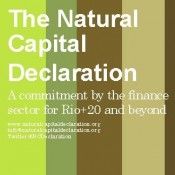The Natural Capital Declaration Moves Forward With Implementation Phase
The Natural Capital Declaration (NCD) has been officially active for almost a year and is now ready to move into the second phase, which is the implementation of four commitments, focused on integrating natural capital into financial accounting, presented in the NCD Roadmap.

The Natural Capital Declaration (NCD) has been officially active for almost a year and is now ready to move into the second phase, which is the implementation of four commitments, focused on integrating natural capital into financial accounting, presented in the NCD Roadmap.
13 June 2013 | Last year at the Rio+ 20 Sustainable Development Conference, the Natural Capital Declaration (NCD) was launched and hailed as one of the most promising initiatives of the conference. Now, almost a year later, the NCD marks the start of Phase II which is explained in detail in the NCD Roadmap. Basically, Phase II is the implementation of the Declaration’s four commitments through the process laid out in the Roadmap.
The NCD is a global project that seeks to integrate natural capital-the ecological goods and services the Earth provides that yields direct and indirect benefits, like water and timber-into financial accounting, disclosure and reporting. In doing so, the Declaration believes it will create a broader understanding of natural capital risks in financial markets. The NCD has been endorsed by investors, insurance firms and banks. A total of 41 CEOs from these financial institutions have signed the document.
The Declaration is administered by the United Nations Environment Programme Finance Initiative (UNEP FI) and the Global Canopy Programme, a think tank focused on halting tropical deforestation. They form the secretariat of the NCD and will oversee the implementation phase along with a steering committee made up of endorsers and supporters.
Phase II will also present what implementation of the Declaration means to potential signatories and others interested in the NCD.
A Commitments Guide
The four commitments are clearly laid out in the Roadmap starting with understanding impacts and dependencies on natural capital. This focuses on how the financial sector’s work with businesses in environmentally sensitive areas can cause risks for the sector. Businesses impact and also depend on natural capital and the NCD calls for a better understanding of this relationship. The Natural Value Initiative is one such project aiming to inform businesses of their dependencies on ecosystem services as well as the link it has to corporate risk.
The second commitment examines the different tools and methods being developed to embed natural capital into financial products such as loans, equities and bonds. This is difficult to do, the NCD document notes, which is why they discuss the various tools in development. For example, natural capital can be embedded in equity investments through screening criteria for Environmental, Social and Governance (ESG) factors and investment analysis. There is also the E-RISC (Environmental Risk in Sovereign Credit) project by UNEP FI and the Global Footprint Network, which assessed the impact natural resource risk has on sovereign credit risk.
Embedding natural capital into financial accounts is necessary as well, the NCD says, and is the third commitment. The proper methodology for companies to use to account for natural capital in their financial statements doesn’t exist yet, although initiatives like the Corporate Ecosystem Valuation has developed frameworks that allow corporations to start valuing ecosystem services. Clients of financial institutions have to recognize that natural capital can be material to them making it material to the financial sector as well, the Declaration reads. In order for this integration to take place, more systematic approaches need to be developed.
Embedding natural capital into financial accounts is also a way for clients of banks and investment firms and other financial institutions to better understand natural capital risk. The fourth commitment is another way for all parties to stay informed. It requires financial institutions disclose and report on the use of natural capital in their operations and supply chains. The goal for this commitment is to create a global agreement on integrated reporting that includes natural capital as part of the resources necessary for companies’ success. But this is a long way off, the Declaration says, and depends largely on how integration and the advancement of ESG tools develop in the third commitment.
Initiatives such as the CDP (formerly the Carbon Disclosure Project) and the Global Reporting Initiative (GRI) have made progress in this space. CDP works with companies and cities around the world to measure and report on their climate, water and forests risk as well as their GHG emissions. The GRI, meanwhile, provides organizations with a sustainability reporting framework that includes natural capital.
The Plan
The NCD Roadmap includes a spot for those interested in signing the Declaration to get involved as well as a spot for non-financial organizations to provide support.
While the NCD is anticipating many challenges in implementing the commitments-particularly from Commitments 3 and 4- they still plan to achieve all four commitments by 2020.
Additional resources
Please see our Reprint Guidelines for details on republishing our articles.

